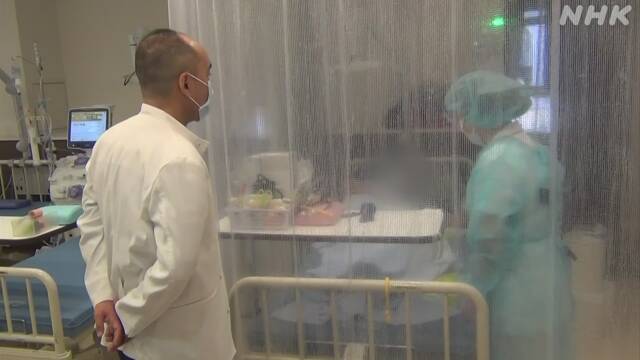Patients undergoing dialysis due to severe kidney disease are likely to become severely ill when infected with the new coronavirus, and in principle, hospitalization is taken, but due to the spread of the current infection, a dedicated bed in Tokyo. Is buried and hospitalization is difficult.
For this reason, from the beginning of this month, mildly ill patients have been on standby at home and switched to receiving dialysis at their own facilities, and doctors in the field are becoming more vulnerable as an emergency.
According to a joint committee created by the Japan Dialysis Medical Association and the Japan Dialysis Medical Association, 16 patients undergoing dialysis were newly infected with the new corona in the week leading up to the 13th of last month. However, the number has surged to 190 by the 27th, 325 by the 3rd of this month, 415 by the 10th, and 350 by the 17th.
Of these, in Tokyo, 78 people were confirmed to be infected in the week up to the 17th, and there are about 140 beds in Tokyo dedicated to corona treatment along with dialysis treatment, which are full from the end of last month. It means that the state of is continuing.
In response to this situation, the Tokyo Metropolitan Government will prioritize the hospitalization of severely and moderately ill patients, so on the 4th of this month, patients who are asymptomatic or mild and do not need assistance will be taken care of at the dialysis facility in Tokyo. We issued a document requesting that dialysis be performed at the dialysis facility in Tokyo, and in principle, the response to hospitalization was switched.
The Tokyo Metropolitan Government is taking measures to support patients, such as transporting patients undergoing medical treatment at home to dialysis facilities.
Dr. Kan Kikuchi, the chairman of the joint committee and coordinating the hospitalization of dialysis patients in Tokyo, said, "I really want all patients to be hospitalized, but now I have to take measures according to the severity. No. It's just an emergency, and it's important to check for changes in physical condition when the patient comes to the hospital. "
At the clinic for accepting new corona patients
At the clinic in Shinjuku Ward, Tokyo, where Dr. Kikuchi, the chairman of the joint committee, is the director, there are multiple booths that allow more than 40 patients to be isolated in a tent in a large room where they can receive artificial dialysis at the hospital. We have set up and accept patients who have been infected with the new corona or who are suspected of being infected every day.
On the 18th, after the infection was confirmed, a patient in his 40s who was receiving medical treatment at home visited the clinic and entered a large room where dialysis was performed through a different entrance from the general patient, and at the edge of the room. I was being treated for dialysis in a booth that kept the air out.
According to the Joint Committee, even in the 6th wave, which is mainly composed of Omicron strains, which are said to have a low risk of aggravation, about 20% of dialysis patients are in a state of "moderate 2" or higher, which requires oxygen administration. It means that it is.
At the clinic, while the patient was on dialysis, a nurse in a protective suit asked if there was any change in her physical condition and checked if the oxygen saturation in the blood had decreased.
Dr. Kikuchi said, "If you keep a space of 2 meters or more from the surrounding bed, or shift the time of dialysis treatment from other patients, spatial isolation and temporal isolation are sufficient, even in a general clinic. We can deal with corona patients. People with stable symptoms must see as much as possible at their own facilities and build a system that allows critically ill patients to be hospitalized, otherwise the current situation cannot be overcome. "
Mortality rate of dialysis patients is still high at 2.7% in "6th wave"
According to a survey by a joint committee created by the Japan Dialysis Medical Association, there were 1386 patients on dialysis who were infected with the "sixth wave" since last month when the Omicron strain expanded, which is at least 2.7%. It means that 37 people have died.
The mortality rate since the onset of infection in Japan was 11.4%, which was significantly lower in the 6th wave, but the mortality rate of all people infected in the 6th wave was about 0.1%, and the number of patients on dialysis was about 0.1%. It's still high.
Looking at the mortality rate of dialysis patients in the 6th wave by age group, no one died in their 30s or younger, but about 1.5% in their 40s, about 0.8% in their 50s, and about 2.6% in their 60s. , 70s is about 3.6%, 80s and over is about 4.1%, which is higher as the age goes up.
"The mortality rate of dialysis patients is considerably higher than that of general patients, and there are many elderly and diabetic patients, and their immunity is weakened," said Kan Kikuchi, chairman of the joint committee. It is necessary to proceed with three vaccinations as soon as possible in order to reduce the number of cases. "

